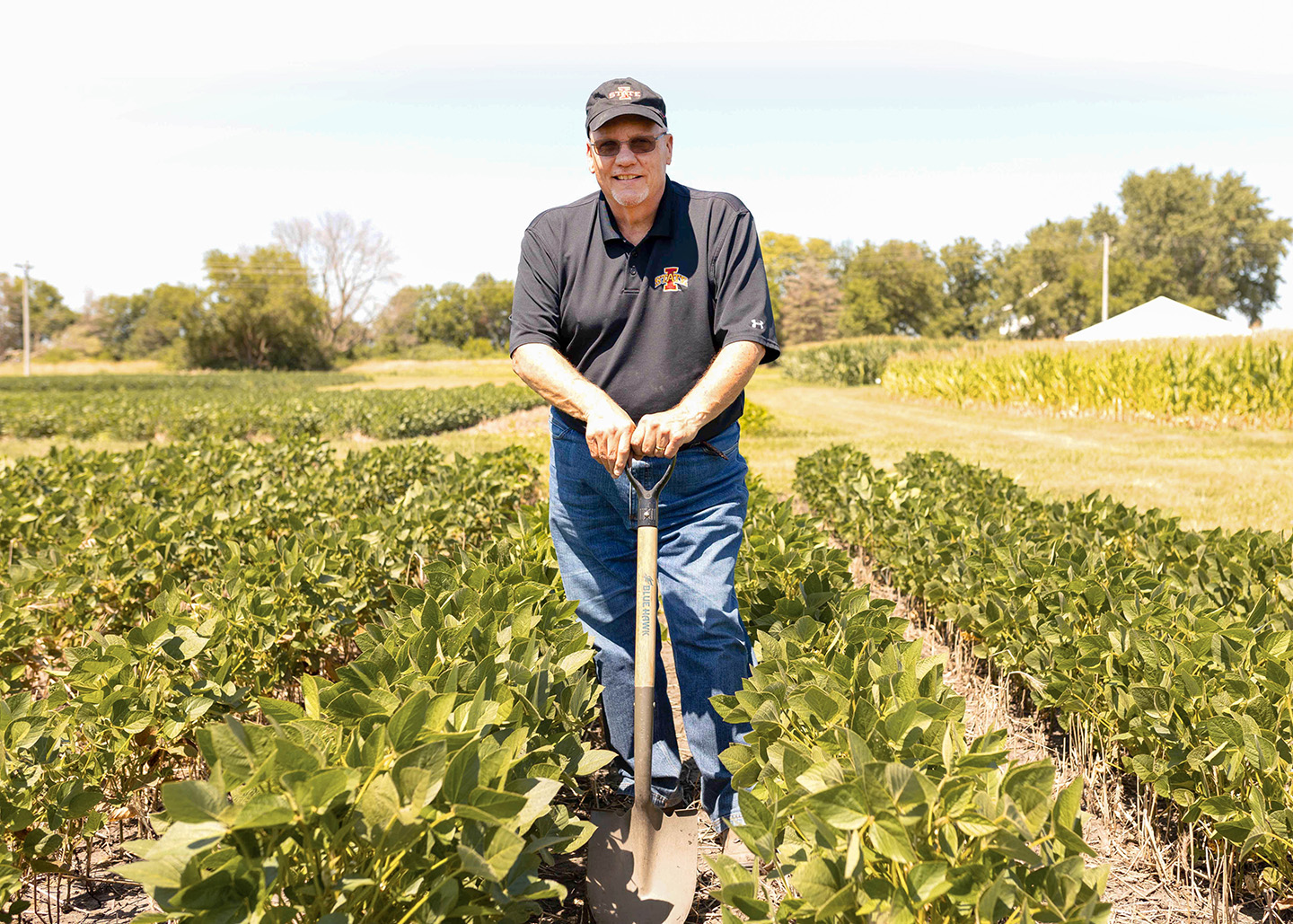
(Photo: Joclyn Bushman/Iowa Soybean Association)
Fall soil testing helps track SCN levels
September 26, 2022 | Kriss Nelson
Don’t overlook testing for Soybean Cyst Nematode (SCN) levels when planning for fall soil testing.
Not only does soil sampling in the fall after harvest allow for easy crisscrossing of an open field to collect soil cores, but producers will also receive SCN results in time to plan for the next season’s crop.
Greg Tylka, Morrill Professor and director of the Iowa Soybean Research Center at Iowa State University (ISU), recommends gathering 20 soil cores from every 20 acres. The cores should be eight inches deep, placed in a bucket, mixed up and put into a soil sampling bag.
If soil sampling for SCN in a field where corn was just harvested, soil cores can be gathered either between or within the rows. However, be cautious not to gather a soil probe full of corn stalks.
Sampling these fields, Tylka says, will provide SCN numbers to consider for planting soybeans in the next season.
“I encourage farmers to sample fields of harvested corn in the fall that will be rotated to soybeans,” says Tylka. SCN numbers can also be sampled after soybean harvest. In this case, soil cores must be gathered consistently between the rows or underneath where the row was located. There might be an increased chance of finding SCN under the old soybean rows, Tylka says.
“The results of soil samples collected after the soybean harvest will be more of a look back rather than a look forward,” says Tylka. “You can see what was there, which might help explain some disappointing soybean yields.”
An alternative approach to soil sampling for SCN is collecting targeted soil samples. Doing so means pulling multiple soil cores eight inches deep from high-risk areas, like field entryways, low-yielding areas, windblown soil near fence lines and high pH spots.
“Through a soybean checkoff-funded research project, we found a consistent correlation between SCN numbers and pH,” says Tylka. “The higher the pH, the higher the SCN number. Since the initial discovery, we have found this relationship consistent throughout the Midwest.”
Soil samples can be sent to the ISU Plant and Insect Diagnostic Clinic.
“When farmers send samples to Iowa State, they receive a report of their results with egg counts and management recommendations,” says Tylka.
Samples can also be sent to a private laboratory trained in SCN sample processing. A list of those laboratories is available at www.TheSCNCoalition.com.
Managing SCN
Rotating corn after soybeans can reduce SCN egg numbers by up to 50%. “From an SCN perspective, it is frightening that people are considering growing beans on beans in Iowa,” says Tylka. “There is not much worse that could happen regarding SCN. We want farmers to grow corn to stop the nematode buildup in those soybean years. Corn is a non-host crop. It is going to drop numbers.”
For the past 25 years, resistant soybean varieties featuring the PI 88788 SCN resistance have been the go-to solution for combating SCN. Unfortunately, that is not the case anymore.
“Almost every soybean variety has resistance to SCN, but it is worn-out resistance that is not very effective anymore,” says Tylka. “If current trends persist, everybody’s SCN numbers will get worse because the pace at which new varieties with more effective or uncommon sources of SCN resistance are becoming available to Iowa farmers is painfully slow.”
Tylka advises looking for soybean varieties featuring the more effective Peking resistance when making seed selection decisions. However, those are not readily available. “Only 5% of the 850-plus soybean varieties available to farmers have Peking as a source of resistance,” says Tylka. “The others have the ineffective PI 88788 resistance. Farmers should look for the hard-to-come-by, effective and higher yielding Peking resistance.”
Jim Legvold, ISA farmer-member from Vincent in Webster County, has been fighting the uphill SCN battle for several years.
Although he looks for Peking resistance in this soybean variety options, he can’t rely on that trait alone. He considers the entire soybean trait package, such as high-yielding and maturity dates, which often means he settles for PI 88788.
“As new-yielding varieties come out, most of the time, they are PI 88788 resistant,” he says. “I have high pH ground, so I have to plant soybeans resistant to high pH in those areas to give me a fighting chance for some yield.”
Soybean checkoff funds have also been used for soybean variety evaluations, helping producers determine which varieties are better than others in nematode control and yield.
Results from evaluations of more than 200 hundred varieties tested annually are available in December by visiting www.isuscntrials.info.

ISA member Jim Legvold has been battling SCN on his farm near Vincent. He’s involved in field trials in his pursuit to beat the pest.
Seed treatments
Tylka is researching seed treatments as the future of SCN management. He advises farmers to conduct on-farm trials.
“I encourage farmers to try some of these on their fields and see which ones appear to give them a yield bump and which ones don’t,” says Tylka. “The treatments contain either a living organism or a chemical described as providing nematode protection for the roots.”
Could biologicals be another weapon used to combat SCN?
Legvold is currently participating in a trial on 70 acres of soil-injected biologicals at planting and is waiting on the harvest for those results.
“SCN is the No. 1 yield robber. I am frustrated, but I am encouraged. Maybe there is a biological out there,” he says. “This might be a steppingstone for me. If this works, I may use this product as we move on or a similar biological.”
On your farm
Contact Drew Clemmensen, ISA field services program manager, to participate in SCN field trials. Call 515-334-1023 or email dclemmensen@iasoybeans.com.
Back